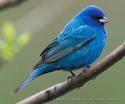-
new bird spotted at the finch bird feeder
Wow… if you think male bluebirds are vibrant blue – check out this little guy! An Indigo Bunting in brilliant cerulean blue was spotted a few days ago at my finch bird feeder. More common in Florida, it’s rare for them to make an appearance in my North Georgia yard. Once, and only once, a Painted Bunting also made a visit to the same finch feeder. Lucky are the folks who see these gorgeous birds on a daily basis!
And fast? They almost as quick as hummingbirds, it was difficult to get a good look at him. Possibly the leaf misters were attractive, or he’d seen all the other bird activity going on? For two or three days now, he’s been spotted at the same feeder.
More than just Goldfinches are attracted to a Finch Bird Feeder. This protective feeder sees many Chipping Sparrows in winter, as well as Chickadees, and House Finches. Just because a bird feeder may be labeled for a specific species, it will always attract more than just that bird. Finch mix is a great staple to offer feathered friends throughout the year.
-
nesting materials that could pose hazards?
There was a pretty strange video and some interesting discussions on one of the birding forums where I’m subscribed. For the above title to make any sense at all, you’d need to watch the very short video about conjoined robins and the follow-up to the story involving nesting materials. Check it out:
Luckily for the robins, they did make it to a caring vet who performed the surgery to separate them pro bono. Turns out genetics were not the culprit, but a small piece of plastic thread in their nesting materials. After they hatched, it had caused there skin and wings to fuse to it, thus developing together. The prognosis for the larger bird is good and he will be released back into the wild. For the smaller robin, his life may be lived out permanently at the rehab center if he survives. His wing needed to be clipped in order to separate the two birds.
Our discards are killing wildlife… especially birds. Fishing line and similar materials pose a life threatening hazard to all wildlife and in particular wild birds. Sadly but surely we kill the planet that sustains us all.
-
blue bird houses vacant?
Using recycled materials greatly helps the environment by reducing waste and keeping said materials out of landfills. It takes about 25 to 40 plastic milk jugs to produce a recycled bird house or feeder. These blue bird houses are NABS approved, (North American Bluebird Society) and create the perfect nesting site for Eastern Bluebirds. With such a large shortage of natural nesting cavities, why would a great nest site like this be vacant?
Several factors will deem successful habitat for birds, and pesticides are detrimental in successful clutches. Environment plays the biggest role in attracting birds, and while everything may be super green and manicured in your yard, it may not be good for your avian friends. Ingested through insects fed by adults, pesticides wreak havoc on developing nestlings. Although sometimes not harmful to the adults, they are deadly to nestlings. If clutches in an area repeatedly fail, the bluebirds are likely to abandon the spot and seek other habitat.
Predators will also discourage nesting. Roaming cats, raccoons, snakes and larger bully birds will drive bluebirds from a possible nest site. House Sparrows and Starlings (both non-native species) will kill adult bluebirds in the nest box, as well as nestlings, and even destroy eggs too. Unfortunately this is common practice. These invasive and destructive birds are likely the main cause for the bluebird’s demise in the 70’s and 80’s. Ever-shrinking natural habitat with fierce competition for available nest sites being the reason.
•Be sure that blue bird houses are erected in proper habitat. Open spaces are preferred, with perching spots for hunting insects.
•Predator guards on bluebird houses also increase chances of successful fledging.
•Keep roaming cats indoors, or ask your neighbor to keep their cat out of your yard.
•Fresh water will entice bluebirds and others.
•Remove old nests (away from the area) after birds have fledged. A blue bird house with an old nest will not be used by another pair of bluebirds seeking a nest box.
•Supplemental feeding (with live mealworms) helps parents raise their young.
•Absolutely… quit the pesticides.



